

MANY of New York’s famous artists were born elsewhere and came to this city because it offers the biggest audience and market for creative expression. Keith Haring moved from Pennsylvania to New York at age 20, and in his short life, left public art across the boroughs. Perhaps on account of its location on the eastern edge of Queens, his untitled 1987 work at Cohen Children’s Hospital in Glen Oaks could be worthy of Forgotten-NY.
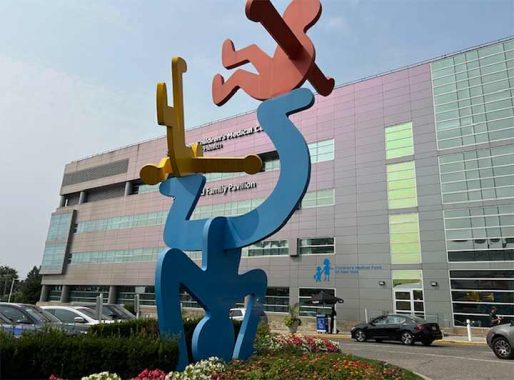
Following its installation, the Haring sculpture became the logo of Schneider Children’s Hospital on the Long Island Jewish campus, which has since been renamed for donors Steven and Alexandra Cohen.
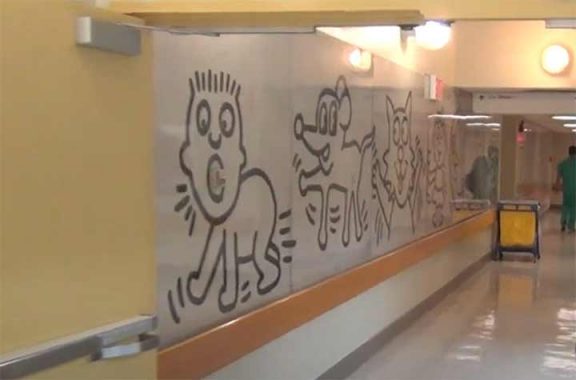
Inside the sizable hospital, Haring painted murals to cheer up the young patients, with cats, dogs, pigs, birds, and flowers on the hallway walls. If you’re unable to get inside, Dr. Thomas Romo III made a video of this artwork in 2018. The hospital’s interior art collection expanded in 2023 with a mural by Corey Paige. As hospitals are concerned, Haring also did a mural at the city-run Woodhull Hospital in Brooklyn, but if you don’t have reason to be inside a hospital, Haring’s other public works in the city include the pool wall at Tony Dapolito Recreation Center, the LGBT Community Center in Greenwich Village, and Crack is Wack Playground in Harlem. Nearby in 2019, a Haring drawing was enlarged into a wall mural at Harlem Hospital’s pediatric department.
The city has proposed razing the Dapolito Center, but I’d have to say the Haring mural would be preserved if that happens. –Ed.

Another facility on the LIJ campus is the Zucker Hillside Hospital, which treats mental and addictive disorders. In 2015, David’s Knot in Flames by Robin Antar was installed here. She created the marble work in memory of her son David, who was a patient at this hospital. The “hillside” in its name does not refer to the nearby avenue, but its initial location north of the city, which I describe below.
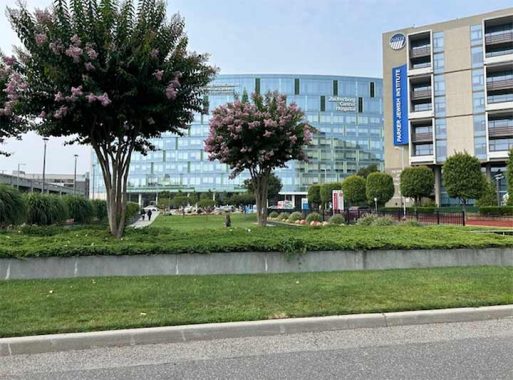
On the eastern side of the LIJ campus is a curvy post-millennial building hosting Katz Women’s Hospital and the Zuckerberg Pavilion, the latter having no relation to the Facebook founder. Its philanthropy namesake is former Goldman Sachs partner Roy J. Zuckerberg.
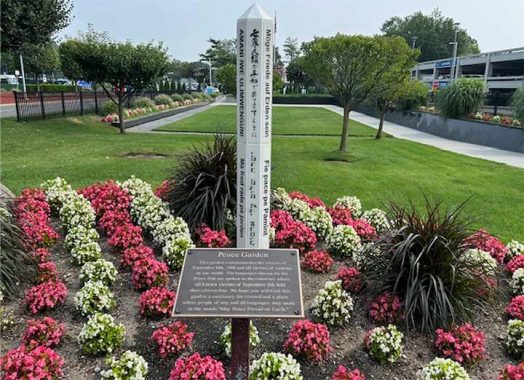
Facing this building is the sunken Peace Garden planted in memory of 9/11 victims, with an octagonal pole on which the phrase “May peace prevail on earth” appears in multiple languages. The Nassau County border runs on a driveway at the eastern end of this garden.
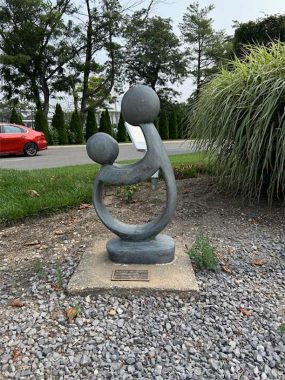
On the Nassau side of the campus is a small sculpture bearing the plaque “Nancy McShane. Dedicated to a life of nursing service.” It does not name its sculptor nor any additional information on Nurse McShane. Comments here are open to your input. There are no lines in the grass to mark the municipal border.
Concerning art at city hospitals, Crain’s offers details on other famous examples, such as a Warhol at Bellevue.
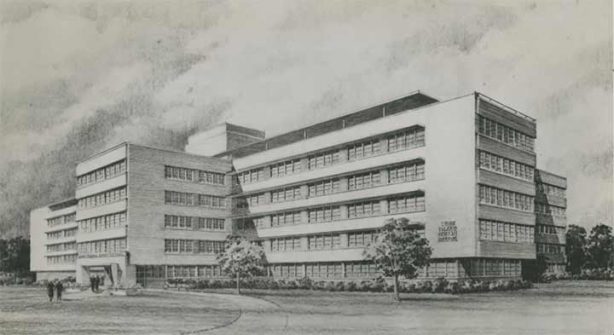
The story of Long Island Jewish Medical Center begins in 1941, when the Hillside Hospital, which served mentally diagnosed patients, relocated here from Hastings-on-Hudson. In 1954, the first LIJ hospital opened next to the Hillside building. Under the Hill-Burton Act of 1946, for every two dollars raised by philanthropy, the federal government contributed a dollar. It spurred a wave of new hospitals across the country during the postwar baby boom. The hospital was nonsectarian but its name was a reminder of a time when many Jewish medical students and doctors faced discrimination in hiring, so they built their own hospitals such as LIJ, Mount Sinai, Maimonides, and Jacobi.
Like LIJ, Hillside also has a Jewish background, as it was founded by Dr. Israel Strauss, the first Jew to graduate from Brown University. They merged in 1971, creating a unified campus while retaining their separate names. In 2015, LIJ merged with North Shore Health Systems, which was renamed Northwell Health in 2015. It is one of the largest private sector employees in the state.
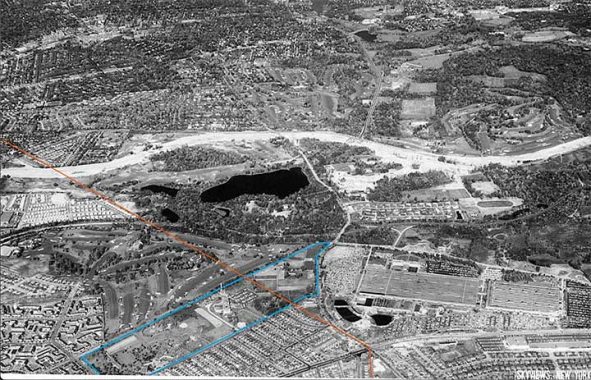
Looking at an aerial survey of LIJ from 1956, perhaps there was an anticipation that this hospital would expand in the coming decades. To its north is the highest point in Queens, the North Shore golf course which later had residential towers built on it. Across the city line in the Village of Lake Success was the Sperry gyroscope factory that served as a temporary headquarters of the United Nations from 1946 to 1952. Northern State Parkway was barely visible among the trees as it only had four lanes at the time. Parallel to it, Long Island Expressway appears under construction, spurring the suburbanization of Long Island.
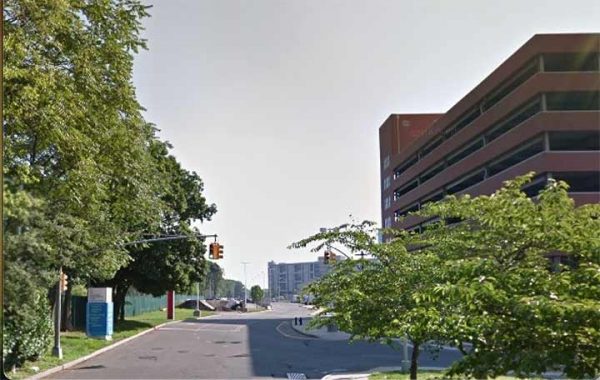
Kevin seems to be itching to leave NYC, or perhaps expand its limits. He documented 271st Street, the highest numbered street in Queens, on the hospital’s southern border in 2025, 2022, and 2011. Further back in 2000, he noted that the Long Island Motor Parkway ran on present-day 74th Avenue, which is on the hospital’s northern edge.
Sergey Kadinsky is the author of Hidden Waters of New York City: A History and Guide to 101 Forgotten Lakes, Ponds, Creeks, and Streams in the Five Boroughs (2016, Countryman Press), adjunct history professor at Touro University and the webmaster of Hidden Waters Blog.
Check out the ForgottenBook, take a look at the gift shop. As always, “comment…as you see fit.” I earn a small payment when you click on any ad on the site.
8/9/25

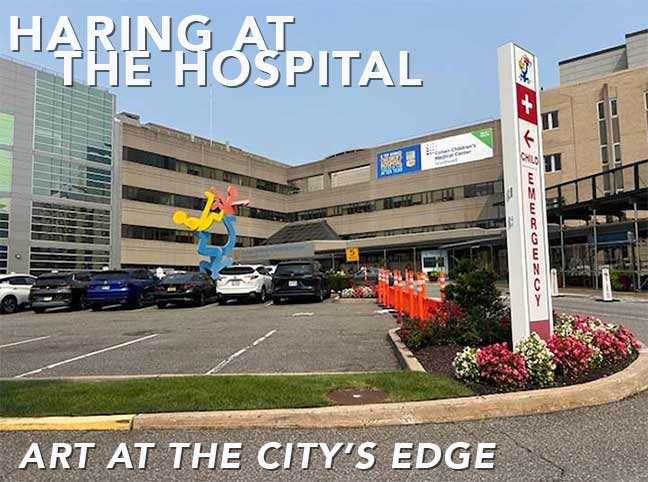
3 comments
Keith Haring was not a nerd, but he sure looked like one.
He said some messed-up things like, in an interview, in Spin or Rolling Stone, “[my paraphrase] they would try to scare us by showing that dropping acid would make you think the blue and orange flames on a stove range were flowers and you want to touch them and pick them. That made me want to take drugs even more.” That would not be bad, except that impressionable youth, like me, would be reading those interviews, not like now where no one reads anything.
Sergey, leave Kevin alone! (Last paragraph.) 😉 I have always enjoyed his use of the term “undefended border”, to describe the territory adjacent to the nearest-by towns and municipalities.